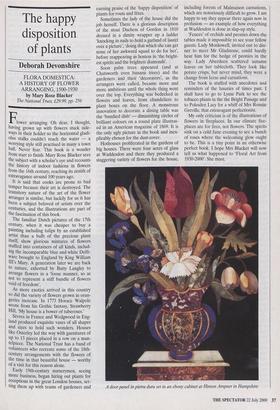The happy disposition of plants
Deborah Devonshire
FLORA DOMESTICA: A HISTORY OF FLOWER ARRANGING, 1500-1930 by Mary Rose Blacker The National Trust, £29.99, pp. 256 lower arranging. Oh dear, I thought, having grown up with flowers stuck side- ways in their holder so the horizontal gladi- olus stalks couldn't reach the water — a worrying style still practised in many a town hall. Never fear. This book is a wonder from start to finish. Mary Rose Blacker sees the subject with a scholar's eye and recounts the history of indoor fashions in flowers from the 16th century, reaching its zenith of extravagance around 100 years ago. It is said that cooks are prone to bad temper because their art is destroyed. The transitory nature of the art of the flower arranger is similar, but luckily for us it has been a subject beloved of artists over the centuries, and the illustrations are part of the fascination of this book.
The familiar Dutch pictures of the 17th century, when it was cheaper to buy a painting including tulips by an established artist than a bulb of the precious plant itself, show glorious mixtures of flowers stuffed into containers of all kinds, includ- ing the incomparable blue and white Delft- ware brought to England by King William III's Mary. A generation later we are back to nature, exhorted by Batty Langley to arrange flowers in a 'loose manner, so as not to represent a stiff bundle of flowers void of freedom'.
As more exotics arrived in this country so did the variety of flowers grown in oran- geries increase. In 1773 Horace Walpole wrote from his Gothic fantasy, Strawberry Hill, 'My house is a bower of tuberoses.'
Sevres in France and Wedgwood in Eng- land produced exquisite vases of all shapes and sizes to hold such wonders. Houses like Osterley led the way with garnitures of up to 13 pieces placed in a row on a man- telpiece. The National Trust has a band of volunteers who recreate some of the 18th- century arrangements with the flowers of the time in that beautiful house — worthy of a visit for this reason alone.
Early 19th-century nurserymen, seeing more business, began hiring out plants for receptions in the great London houses, set- ting them up with teams of gardeners and earning praise of the 'happy disposition' of plants for routs and fetes. Sometimes the lady of the house did the job herself. There is a glorious description of the stout Duchess of Gordon in 1810 dressed in a dimity wrapper up a ladder `knocking in nails to hold a garland of laurel over a picture', 'doing that which she can get none of her awkward squad to do for her', before reappearing as hostess in 'the bright- est spirits and the brightest diamonds'. Soon palm trees appeared (and at Chatsworth even banana trees) and the gardeners and their 'decorators', as the arrangers were called, became more and more ambitious until the whole thing went over the top. Everything was bedecked in flowers and leaves, from chandeliers to plant boxes on the floor. A monstrous innovation to decorate a dining table was the 'bandied dish' — diminishing circles of brilliant colours on a round plate illustrat- ed in an American magazine of 1869. It is the only ugly picture in the book and inex- plicably chosen for the dust-cover.
Hothouses proliferated in the gardens of big houses. There were four acres of glass at Waddesdon and there they produced a staggering variety of flowers for the house,
including forests of Malmaison carnations, which are notoriously difficult to grow. I am happy to say they appear there again now in profusion — an example of how everything at Waddesdon is done in slap-up style.
`Fences' of orchids and peonies down the tables made it impossible to see your fellow guests. Lady Monkswell, invited out to din- ner to meet Mr Gladstone, could hardly hear him for the hedge of peonies in the way. Lady Aberdeen scattered autumn leaves on her tablecloth. They look like potato crisps, but never mind, they were a change from ferns and carnations.
The book is stuffed with anecdotes and reminders of the luxuries of times past. I shall have to go to Lyme Park to see the tobacco plants in the the Bright Passage and to Polesden Lacy for a whiff of Mrs Ronnie Greville, that extravagant perfectionist.
My only criticism is of the illustrations of flowers in fireplaces. In our climate fire- places are for fires, not flowers. The spirits sink on a cold June evening to see a bunch of roses where the welcoming glow ought to be. This is a tiny point in an otherwise perfect book. 1 hope Mrs Blacker will now tell us what happened to 'Floral Art from 1930-2000'. She must.
A door panel in pietra dura set in an ebony cabinet at Hinton Ampner in Hampshire


























































 Previous page
Previous page